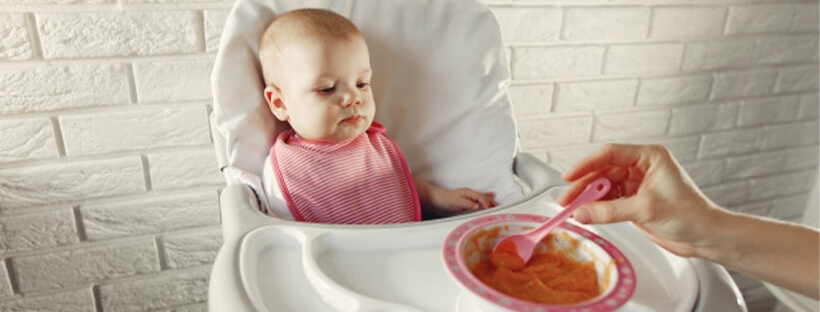Starting with Semi solids food : how to check test readiness in babies
 19282
19282

super easy
Food and nutrition is the most basic necessity for any living being. For some, food is just a mode of nutrition, while for others, food is life, and for your baby, food means proper growth and fundamental development. Even before a child is born, you must have been given a proper diet, and you had to eat double because now, you were not the singular consumer. Now, after your baby is out in the world, you must understand that there is a difference between your nutrition and your infant’s nutrition. The food you eat can’t be given to the baby, at least for the initial 6 months. But still, if you want to start with semi solid foods, you might need guidance provided here:
● What is semi-solid food?
As the name suggests, semi-solid food includes the food which isn’t hard or solid, which needs to be chewed by teeth. Since babies lack teeth in their initial months, whatever food is being provided to them should able to be crushed by the gums. You can provide mashed fruits or vegetables, ground meat, iron-fortified baby cereal mixed with more or less formula or breast milk because babies below one year of age can’t digest the proteins present in whole milk.
When to start?
According to the American Academy of Paediatrics, before 4-6 months of age, the infants don’t develop the skills to ingest food. Till the initial 6 months, the majority of the meal or food should come from breastmilk or formula milk. The best time to introduce these foods to babies is when they have developed the skills to eat. Babies have the natural tongue-thrust reflex (when a mouthful of food is given to a baby, he pushes it right back out with his tongue) till the first 4-6 months; therefore, obviously, they can’t ‘eat’ the food.
● How to test readiness?
A lot of times, it can happen that your baby is ready to be subjected to semi-solids prematurely. How to know that? The following are some indicators to know if they are ready: ⮚ A baby must have good neck and head control and should be able to sit up in a high chair in order to eat. ⮚ The baby must show an interest in food. He must smack his lips, reach out for the food, and open their mouth when approached with food, eagerly watch when others are eating etcetera. ⮚ They ideally should weight close to double their birth weight. ⮚ They should have lost their natural tongue-thrust reflex by now.
● How to start semi-solids?
You should definitely wait for at least 4 months before going for semi-solids. Infants create a lot of mess and fuss while eating. Be persistent for a few days, and if your baby still pushes out the food, you need to wait a bit more. Now, if your baby is ready to receive it, you must be worried about how to go about feeding them. Feeding babies can be a mammoth task. For a start, you can provide one semi-solid meal along with two courses of breast milk. Till the age of 1 year, this must be their major source of nutrition. Initially, it’s better to start with single-grain, iron-fortified cereal to be fed with a small spoon. You can grind vegetables, fruits, and meat at home with added salt or sugar as desired or maybe without it. When your baby gets the hang of eating the first food, introduce others, such as puréed beans, lentils, or yogurt. Wait a few days between introducing new foods to make sure your baby doesn’t have an allergic reaction. You can gradually increase the solids after 8 months or so. Starting with Semi-solids: How and what to start and how to check test readiness in babies
● Some cautions
Forcing the baby to consume food just because you feel he is ready is a big NO. If you need to put the cereal or food in a bottle or dropper to make the baby consume it, you need to hold on as the baby might not be ready for it. We parents must follow the cues of the baby and shouldn’t become the members of the ‘clean plate club.’ Stressing your baby to finish the food anyhow can lead to weight problems and obesity. If the little ones are not ready, they can choke on the food or push it into their windpipe or lungs, which can be dangerous. You must avoid homegrown spinach, carrots, beans, beets, etc. which contain high levels of nitrogen, which can cause anemia in babies. DO NOT give then fruit juices as they can cause obesity, less space for nutritious food without causing any good.
A baby’s health and nutrition is a parent’s top priority. The above guide would help you formulate your baby’s semi-solid diet. It’s always advisable to consult a pediatrician and get affirmation from them regarding the diet of the baby. Mother’s milk is the best package for a child’s nourishment as it naturally has all the required nutrients. Keep exploring carefully and read your baby’s pointers. You will learn it with experience slowly. You can enjoy your favorite food without sharing it for at least a few more months. Why not grab the opportunity.





Leave a Reply